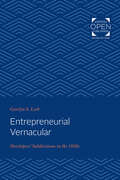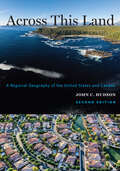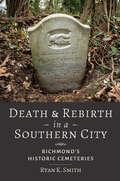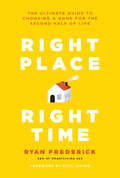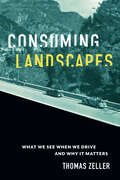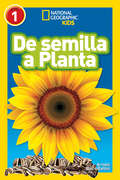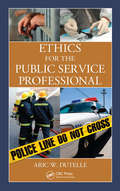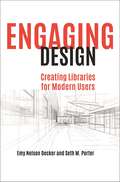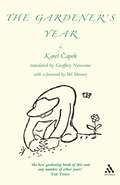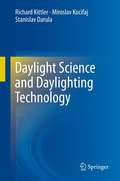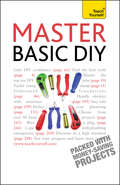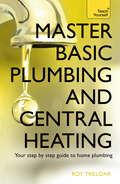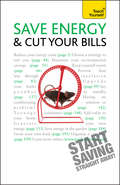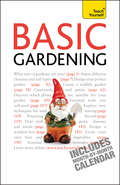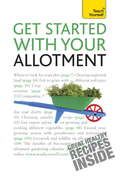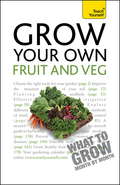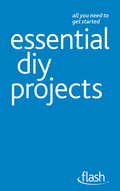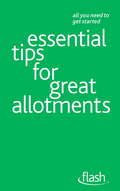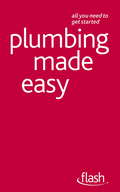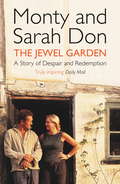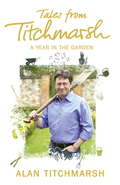- Table View
- List View
Entrepreneurial Vernacular: Developers' Subdivisions in the 1920s (Creating the North American Landscape)
by Carolyn S. LoebOriginally published in 2001. Suburban subdivisions of individual family homes are so familiar a part of the American landscape that it is hard to imagine a time when they were not common in the U. S. The shift to large-scale speculative subdivisions is usually attributed to the period after World War II. In Entrepreneurial Vernacular: Developers' Subdivisions in the 1920s, Carolyn S. Loeb shows that the precedents for this change in single-family home design were the result of concerted efforts by entrepreneurial realtors and other housing professionals during the 1920s. In her discussion of the historical and structural forces that propelled this change, Loeb focuses on three typical speculative subdivisions of the 1920s and on the realtors, architects, and building-craftsmen who designed and constructed them. These examples highlight the "shared set of planning and design concerns" that animated realtors (whom Loeb sees as having played the "key role" in this process) and the network of housing experts with whom they associated. Decentralized and loosely coordinated, this network promoted home ownership through flexible strategies of design, planning, financing, and construction which the author describes as a new and "entrepreneurial" vernacular.
Across This Land: A Regional Geography of the United States and Canada (Creating the North American Landscape)
by John HudsonBased on decades of research and written in clear, concise prose by one of the foremost geographers in North America, John C. Hudson's Across This Land is a comprehensive regional geography of the North American continent. Dividing the terrain into ten regions, which are then subdivided into twenty-seven smaller areas, Hudson's brisk narrative reveals the dynamic processes of each area's distinctive place-specific characteristics. Focusing on how human activities have shaped and have been shaped by the natural environment, Hudson considers physical, political, and historical geography. He also highlights related topics, including resource exploitation, economic development, and population change. Praised in its first edition as a readable and reliable interpretation of United States and Canadian geography, the revised Across This Land retains these strengths while adding substantial new material. Incorporating the latest available population and economic data, this thoroughly updated edition includes• reflections on new developments, such as resource schemes, Native governments in Atlantic Canada, and the role of climate change in the Arctic• a new section focused on the US Pacific insular territories west of Hawaii• evolving views of oil and gas production resulting from the introduction of hydraulic fracturing• revised text and maps involving agricultural production based on the 2017 Census of Agriculture• current place names• more than 130 photographsThe most extensive regional geography of the North American continent on the market, Hudson's Across This Land will continue as the standard text in geography courses dealing with Canada and the United States, as well as a popular reference work for scholars, students, and lay readers.
Across This Land: A Regional Geography of the United States and Canada (Creating the North American Landscape)
by John HudsonBased on decades of research and written in clear, concise prose by one of the foremost geographers in North America, John C. Hudson's Across This Land is a comprehensive regional geography of the North American continent. Dividing the terrain into ten regions, which are then subdivided into twenty-seven smaller areas, Hudson's brisk narrative reveals the dynamic processes of each area's distinctive place-specific characteristics. Focusing on how human activities have shaped and have been shaped by the natural environment, Hudson considers physical, political, and historical geography. He also highlights related topics, including resource exploitation, economic development, and population change. Praised in its first edition as a readable and reliable interpretation of United States and Canadian geography, the revised Across This Land retains these strengths while adding substantial new material. Incorporating the latest available population and economic data, this thoroughly updated edition includes• reflections on new developments, such as resource schemes, Native governments in Atlantic Canada, and the role of climate change in the Arctic• a new section focused on the US Pacific insular territories west of Hawaii• evolving views of oil and gas production resulting from the introduction of hydraulic fracturing• revised text and maps involving agricultural production based on the 2017 Census of Agriculture• current place names• more than 130 photographsThe most extensive regional geography of the North American continent on the market, Hudson's Across This Land will continue as the standard text in geography courses dealing with Canada and the United States, as well as a popular reference work for scholars, students, and lay readers.
Death and Rebirth in a Southern City: Richmond's Historic Cemeteries
by Ryan K. SmithRichmond, Virginia, the former capital of the Confederacy, holds one of the most dramatic landscapes of death in the nation. Its burial grounds show the sweep of Southern history on an epic scale, from the earliest English encounters with the Powhatan at the falls of the James River through slavery, the Civil War, and the long reckoning that followed. And while the region's deathways and burial practices have developed in surprising directions over these centuries, one element has remained stubbornly the same: the color line. But something different is happening now. The latest phase of this history points to a quiet revolution taking place in Virginia and beyond. Where white leaders long bolstered their heritage and authority with a disregard for the graves of the disenfranchised, today activist groups have stepped forward to reorganize and reclaim the commemorative landscape for the remains of people of color and religious minorities. In Death and Rebirth in a Southern City, Ryan K. Smith explores more than a dozen of Richmond's most historically and culturally significant cemeteries. He traces the disparities between those grounds which have been well-maintained, preserving the legacies of privileged whites, and those that have been worn away, dug up, and built over, erasing the memories of African Americans and indigenous tribes. Drawing on extensive oral histories and archival research, Smith unearths the heritage of these marginalized communities and explains what the city must do to conserve these gravesites and bring racial equity to these arenas for public memory. He also shows how the ongoing recovery efforts point to a redefinition of Confederate memory and the possibility of a rebirthed community in the symbolic center of the South.The book encompasses, among others, St. John's colonial churchyard; African burial grounds in Shockoe Bottom and on Shockoe Hill; Hebrew Cemetery; Hollywood Cemetery, with its 18,000 Confederate dead; Richmond National Cemetery; and Evergreen Cemetery, home to tens of thousands of black burials from the Jim Crow era. Smith's rich analysis of the surviving grounds documents many of these sites for the first time and is enhanced by an accompanying website, www.richmondcemeteries.org. A brilliant example of public history, Death and Rebirth in a Southern City reveals how cemeteries can frame changes in politics and society across time.
Death and Rebirth in a Southern City: Richmond's Historic Cemeteries
by Ryan K. SmithRichmond, Virginia, the former capital of the Confederacy, holds one of the most dramatic landscapes of death in the nation. Its burial grounds show the sweep of Southern history on an epic scale, from the earliest English encounters with the Powhatan at the falls of the James River through slavery, the Civil War, and the long reckoning that followed. And while the region's deathways and burial practices have developed in surprising directions over these centuries, one element has remained stubbornly the same: the color line. But something different is happening now. The latest phase of this history points to a quiet revolution taking place in Virginia and beyond. Where white leaders long bolstered their heritage and authority with a disregard for the graves of the disenfranchised, today activist groups have stepped forward to reorganize and reclaim the commemorative landscape for the remains of people of color and religious minorities. In Death and Rebirth in a Southern City, Ryan K. Smith explores more than a dozen of Richmond's most historically and culturally significant cemeteries. He traces the disparities between those grounds which have been well-maintained, preserving the legacies of privileged whites, and those that have been worn away, dug up, and built over, erasing the memories of African Americans and indigenous tribes. Drawing on extensive oral histories and archival research, Smith unearths the heritage of these marginalized communities and explains what the city must do to conserve these gravesites and bring racial equity to these arenas for public memory. He also shows how the ongoing recovery efforts point to a redefinition of Confederate memory and the possibility of a rebirthed community in the symbolic center of the South.The book encompasses, among others, St. John's colonial churchyard; African burial grounds in Shockoe Bottom and on Shockoe Hill; Hebrew Cemetery; Hollywood Cemetery, with its 18,000 Confederate dead; Richmond National Cemetery; and Evergreen Cemetery, home to tens of thousands of black burials from the Jim Crow era. Smith's rich analysis of the surviving grounds documents many of these sites for the first time and is enhanced by an accompanying website, www.richmondcemeteries.org. A brilliant example of public history, Death and Rebirth in a Southern City reveals how cemeteries can frame changes in politics and society across time.
Right Place, Right Time: The Ultimate Guide to Choosing a Home for the Second Half of Life
by Ryan FrederickWondering where to live in your later years? This strategic and thoughtful guide is aimed at anyone looking to determine the best place to call home during the second half of life.Place plays a significant but often unacknowledged role in health and happiness. The right place elevates personal well-being. It can help promote purpose, facilitate human connection, catalyze physical activity, support financial health, and inspire community engagement. Conversely, the wrong place can be detrimental to health, as the COVID-19 pandemic has highlighted. In Right Place, Right Time, Ryan Frederick argues that where you live matters enormously—especially during the second half of your life. Frederick, the CEO of SmartLiving 360 and a recognized thought leader on the intersection of place and healthy aging, provides you with tools to evaluate your living situation, ensuring that you weigh all the necessary factors to make a sound decision that optimizes your current and future well-being. He explores the pros and cons of different living options, from remaining in your current home to downsizing, intergenerational living, co-housing, senior living, and more. Along the way, he helps readers answer important questions, including "Are you already in the right place?" and "In what areas does your current place not align with your needs and desires?" The rest of the book helps you to unpack specific options for place, beginning with considerations for regions and neighborhoods and then looking at specific housing models. It also focuses on how housing is changing, particularly from a technology, health, and health care perspective. The book closes by challenging the reader to develop a discipline of choosing the right place at the right time.Combining real-life stories about people selecting places to live with design thinking principles and interactive tools, Right Place, Right Time will appeal to empty nesters, retirees, solo agers, and even adult children seeking ways to support their parents and loved ones.
Right Place, Right Time: The Ultimate Guide to Choosing a Home for the Second Half of Life
by Ryan FrederickWondering where to live in your later years? This strategic and thoughtful guide is aimed at anyone looking to determine the best place to call home during the second half of life.Place plays a significant but often unacknowledged role in health and happiness. The right place elevates personal well-being. It can help promote purpose, facilitate human connection, catalyze physical activity, support financial health, and inspire community engagement. Conversely, the wrong place can be detrimental to health, as the COVID-19 pandemic has highlighted. In Right Place, Right Time, Ryan Frederick argues that where you live matters enormously—especially during the second half of your life. Frederick, the CEO of SmartLiving 360 and a recognized thought leader on the intersection of place and healthy aging, provides you with tools to evaluate your living situation, ensuring that you weigh all the necessary factors to make a sound decision that optimizes your current and future well-being. He explores the pros and cons of different living options, from remaining in your current home to downsizing, intergenerational living, co-housing, senior living, and more. Along the way, he helps readers answer important questions, including "Are you already in the right place?" and "In what areas does your current place not align with your needs and desires?" The rest of the book helps you to unpack specific options for place, beginning with considerations for regions and neighborhoods and then looking at specific housing models. It also focuses on how housing is changing, particularly from a technology, health, and health care perspective. The book closes by challenging the reader to develop a discipline of choosing the right place at the right time.Combining real-life stories about people selecting places to live with design thinking principles and interactive tools, Right Place, Right Time will appeal to empty nesters, retirees, solo agers, and even adult children seeking ways to support their parents and loved ones.
Consuming Landscapes: What We See When We Drive and Why It Matters
by Thomas ZellerWhat we see through our windshields reflects ideas about our national identity, consumerism, and infrastructure.For better or worse, windshields have become a major frame for viewing the nonhuman world. The view from the road is one of the main ways in which we experience our environments. These vistas are the result of deliberate historical forces, and humans have shaped them as they simultaneously sought to be transformed by them. In Consuming Landscapes, Thomas Zeller explores how what we see while driving reflects how we view our societies and ourselves, the role that consumerism plays in our infrastructure, and ideas about reshaping the environment in the twentieth century.Zeller breaks new ground by comparing the driving experience and the history of landscaped roads in the United States and Germany, two major automotive countries. He focuses specifically on the Blue Ridge Parkway in the United States and the German Alpine Road as case studies. When the automobile was still young, an early twentieth-century group of designers—landscape architects, civil engineers, and planners—sought to build scenic infrastructures, or roads that would immerse drivers in the landscapes that they were traversing. As more Americans and Europeans owned cars and drove them, however, they became less interested in enchanted views; safety became more important than beauty. Clashes between designers and drivers resulted in different visions of landscapes made for automobiles. As strange as it may seem to twenty-first-century readers, many professionals in the early twentieth century envisioned cars and roads, if properly managed, as saviors of the environment. Consuming Landscapes illustrates how the meaning of infrastructures changed as a result of use and consumption. Such changes indicate a deep ambivalence toward the automobile and roads, prompting the question: can cars and roads bring us closer to nature while deeply altering it at the same time?
Consuming Landscapes: What We See When We Drive and Why It Matters
by Thomas ZellerWhat we see through our windshields reflects ideas about our national identity, consumerism, and infrastructure.For better or worse, windshields have become a major frame for viewing the nonhuman world. The view from the road is one of the main ways in which we experience our environments. These vistas are the result of deliberate historical forces, and humans have shaped them as they simultaneously sought to be transformed by them. In Consuming Landscapes, Thomas Zeller explores how what we see while driving reflects how we view our societies and ourselves, the role that consumerism plays in our infrastructure, and ideas about reshaping the environment in the twentieth century.Zeller breaks new ground by comparing the driving experience and the history of landscaped roads in the United States and Germany, two major automotive countries. He focuses specifically on the Blue Ridge Parkway in the United States and the German Alpine Road as case studies. When the automobile was still young, an early twentieth-century group of designers—landscape architects, civil engineers, and planners—sought to build scenic infrastructures, or roads that would immerse drivers in the landscapes that they were traversing. As more Americans and Europeans owned cars and drove them, however, they became less interested in enchanted views; safety became more important than beauty. Clashes between designers and drivers resulted in different visions of landscapes made for automobiles. As strange as it may seem to twenty-first-century readers, many professionals in the early twentieth century envisioned cars and roads, if properly managed, as saviors of the environment. Consuming Landscapes illustrates how the meaning of infrastructures changed as a result of use and consumption. Such changes indicate a deep ambivalence toward the automobile and roads, prompting the question: can cars and roads bring us closer to nature while deeply altering it at the same time?
De Semilla a Planta (National Geographic Reader)
by National Geographic Kids Kristin Baird RattiniLos niños observan las plantas, las flores y los arboles a su alrededor todos los días.
Ethics for the Public Service Professional
by Aric W. DutellePublic service professionals � government officials, those in the legal system, first responders, and investigators � confront ethical issues every day. In an environment where each decision can mean the difference between life and death or freedom and imprisonment, deciding on an ethical course of action can pose challenges to even the most season
Engaging Design: Creating Libraries for Modern Users
by Emy Nelson Decker Seth M. PorterThis book demonstrates how aesthetics, design elements, and visual literacy can be implemented in the library to enhance spaces, programs, services, instruction, and outreach so that your library will appeal to all users.Libraries have come to accept that they must rethink how they appeal to users, and harnessing the power of design can be a powerful means for addressing the changing needs of the community. Decker and Porter introduce "engaging design"—an umbrella term that incorporates multiple design frameworks with a focus on a three-prong approach: aesthetics, design thinking, and service design. These frameworks can be used to guide design choices that will aid in teaching and engaging current and potential library users.In the course of a lively and interesting narrative, Engaging Design introduces basic concepts of aesthetics and good design and explores examples of its successful uses in the academic, public, and special library. It provides simple steps for implementing subtle, but powerful, techniques to improve instruction, human-computer interaction, e-learning, public services spaces, wayfinding signage, and all manner of library programs, events, and services. In addition, the authors recommend easy-to-implement best practices that will help librarians to enhance library-goers' experience. Library administrators will also look to this book for assistance in best addressing the needs of the modern library user.
The Gardener's Year
by Karel CapekIt is seldom that a practical guide to gardening attains the level of a literary masterpiece, still more seldom that a book on gardening can amuse and instruct even those who have no garden to plant., nor the faintest interest in acquiring one. The Gardener's Year is a charismatic product of Karel Capek's genius: amusing, informative, and full of a quizzical interest in people, animals and plants.In this new version, Geoffrey Newsome -the highly acclaimed translator of Capek's witty Letters from England -has captured the grace and irony of the original Czech, to produce a volume that will be treasured equally by those who love gardening as a relaxation, by those who loathe it as a chore, and by those who have no interest in it whatsoever.
Daylight Science and Daylighting Technology
by Richard Kittler Miroslav Kocifaj Stanislav DarulaSunlight profoundly influences the Earth's atmosphere and biosphere. Nature fuels the evolution of all living things, their visual systems, and the manner in which they adapt, accommodate, and habituate.Sun luminance measurements serve as data to calculate typical changes in the daily, monthly, and annual variability characteristics of daylight. Climate-based sky luminance patterns are used as models in predicting daylighting calculation and computer programs applied in architecture and building design. Historically, daylight science and daylighting technology has prioritized photometric methods of measurements, calculation, and graphical tools aimed at predicting or evaluating the daylighting of architectural design alternatives.However, due to a heightened awareness of general health and well-being, sunlight exposure and freedom from visual discomfort while undertaking visual tasks are now equally prioritized. Therefore, in order to assure optimal environmental quality, daylighting technology must be based on sound science.Daylight Science and Daylighting Technology, by Richard Kittler, Miroslav Kocifaj, and Stanislav Darula, sketches the entire evolution of daylight science from atmospheric science through apt visual workplace psychophysics.
Master Basic DIY: Teach Yourself (Teach Yourself - General Ser.)
by DIY DoctorMaster Basic DIY explains all the basic tasks and gives you all the information you need to undertake essential decorating and maintenance in an informed and sensible manner. It offers insight into complex options and methods, and is full of practical information and indispensable tips to enable you to quickly see the results reflected in your DIY projects.NOT GOT MUCH TIME?One, five and ten-minute introductions to key principles to get you started.AUTHOR INSIGHTSLots of instant help with common problems and quick tips for success, based on the author's many years of experience.TEST YOURSELFTests in the book and online to keep track of your progress.EXTEND YOUR KNOWLEDGEExtra online articles at www.teachyourself.com to give you a richer understanding of basic DIY.FIVE THINGS TO REMEMBERQuick refreshers to help you remember the key facts.TRY THISInnovative exercises illustrate what you've learnt and how to use it.
Master Basic Plumbing And Central Heating: A quick guide to plumbing and heating jobs, including basic emergency repairs (Teach Yourself)
by Roy TreloarThis guide to the basics of plumbing and central heating is designed for complete amateurs, and written by one of the most experienced plumbing tutors in the country.Whether you are attempting projects such as installing a new bathroom or plumbing in a new dishwasher, or just need to understand enough to do essential repairs and fixes, this is the book for you. It includes step-by-step guides to sorting out the most common plumbing problems, and comprehensive coverage of the key tasks, all based on a straightforward introduction to the layout of your house and water system. In addition, it has plenty of illustrations, a full glossary, a whole chapter on how and who to call for help, a guide to the necessary toolkit and a list of the top ten plumbing emergencies.
Save Energy and Cut Your Bills: Teach Yourself (Teach Yourself)
by Nick WhiteSave Energy and Cut Your Bills offers you straightforward and achievable strategies for reducing your energy bills and living a more environmentally aware life.With lots of useful tools to assess your energy and carbon use, it gives practical advice on everything from heating your home to managing teenage consumers. Includes:-Energy-saving actions categorized into 'no cost', 'low cost' and 'investment' actions.-Detailed installation costs and savings help you to make more effective decisions.-Topical issues, such as HIPs and smart metering-Guidance on the most effective ways of generating your own power.- Suggestions for green driving and being more sustainable in the garden.-Resource sections for further investigation and assistance.NOT GOT MUCH TIME?One, five and ten-minute introductions to key principles to get you started.AUTHOR INSIGHTSLots of instant help with common problems and quick tips for success, based on the author's many years of experience.TEST YOURSELFTests in the book and online to keep track of your progress.EXTEND YOUR KNOWLEDGEExtra online articles at www.teachyourself.com to give you a richer understanding of how to save energy.FIVE THINGS TO REMEMBERQuick refreshers to help you remember the key facts.TRY THISInnovative exercises illustrate what you've learnt and how to use it.
Basic Gardening: A step by step guide to garden care and growing fruit, flowers and vegetables (Teach Yourself)
by Jane McMorland HunterTeach Yourself - the world's leading learning brand - is relaunched in 2010 as a multi-platform experience that will keep you motivated to achieve your goals. Let our expert author guide you through this brand new edition, with personal insights, tips, energising self-tests and summaries throughout the book. Go online at www.teachyourself.com for tests, extension articles and a vibrant community of like-minded learners. And if you don't have much time, don't worry - every book gives you 1, 5 and 10-minute bites of learning to get you started.""Basic Gardening"" features step-by-step guidelines to every aspect of garden care.It covers all the basics, taking nothing for granted, in addition to lots of information on areas of topical interest, such as how to save water during a drought period and how to compost. With straightforward guidelines for growing your own fruit and vegetables, ""Basic Gardening"" shows you how to turn a patch of muddy ground into an easily maintainable garden, whatever the size of your plot and however busy you are. From lawn care and watering to creating patios and growing vegetables, it is packed with easy-to-follow, practical advice.
Get Started with Your Allotment (Teach Yourself)
by Geoff StokesTeach Yourself - the world's leading learning brand - is relaunched in 2010 as a multi-platform experience that will keep you motivated to achieve your goals. Let our expert author guide you through this brand new edition, with personal insights, tips, energising self-tests and summaries throughout the book. Go online at www.teachyourself.com for tests, extension articles and a vibrant community of like-minded learners. And if you don't have much time, don't worry - every book gives you 1, 5 and 10-minute bites of learning to get you started. - Are you keen to get an allotment, but don't know where to start? - Would you like help to successfully grow your own produce? - Are you thinking about keeping livestock on your allotment?""Get Started with Your Allotment"" is written by the UK's leading Allotment Society and designed specifically for all those new to allotments. It will take you step-by-step through the joys of allotment gardening, right from the very first stages of finding an allotment through to keeping livestock. It is designed for both beginners and those with some experience, and has plenty of information for those who wish to involve their children and family members in their new pursuit. With a complete guide to the tools needed, the ideal crops to grow, the soil conditions, troubleshooting and plenty of legal advice, it is the most complete guide available from the country's most experienced and trusted source of allotment wisdom.
Grow Your Own Fruit and Veg: Teach Yourself (Teach Yourself)
by Michael ThurlowGrow Your Own Fruit and Veg: Teach Yourself will guarantee success for anyone wishing to grow fresh produce in any patch of earth, be it garden, allotment or series of containers. This book gives specific instructions on when, where and how to grow and maintain various fruit and vegetables, from the more basic to the exotic, without the use of chemicals. It includes an A-Z list of plants together with ease of growth ratings and an approach that welcomes involvement from the whole family. Whatever your plans for home-grown fruit and vegetables this is the essential guide.Teach Yourself - the world's leading learning brand - is relaunched in 2010 as a multi-platform experience that will keep you motivated to achieve your goals. Let our expert author guide you through this brand new edition, with personal insights, tips, energising self-tests and summaries throughout the book. Go online at www.teachyourself.com for tests, extension articles and a vibrant community of like-minded learners. And if you don't have much time, don't worry - every book gives you 1, 5 and 10-minute bites of learning to get you started.* Shows you what to plant and when* Gives you tips and techniques for success* Offers a full list of plants, from A to Z
Essential DIY Projects: Flash (Flash)
by DIY DoctorThe books in this bite-sized new series contain no complicated techniques or tricky materials, making them ideal for the busy, the time-pressured or the merely curious. Essential DIY Projects is a short, simple and to-the-point guide to that will teach you a number of essential projects around the house in just 96 pages. Suitable even for those who've never picked up a hammer, this is an ideal starting point for the new home-owner or tentative DIY-er.
Essential Tips for Great Allotments: All You Need To Get Started (Flash)
by Geoff StokesThe books in this bite-sized new series contain no complicated techniques or tricky materials, making them ideal for the busy, the time-pressured or the merely curious. Essential Tips for Great Allotments: Flash is a short, simple and to-the-point guide that will teach you all the fundamentals for your allotment, from what tools to use to which crops to grow in just 96 pages. For those new to allotments, this is an ideal starting point for growing your own produce organically.
Plumbing Made Easy: Plumbing Made Easy (Flash)
by Roy TreloarThe books in this bite-sized new series contain no complicated techniques or tricky materials, making them ideal for the busy, the time-pressured or the merely curious. Plumbing Made Easy is a short, simple and easy to follow guide to mastering some simple plumbing jobs that might occur on an everyday basis. By learning some basic skills and techniques you can learn how to carry out repairs and simple projects - in just 96 pages. Ideal for the busy or the thrifty, Plumbing Made Easy is a quick, to-the-point guide for those who want to complete simple plumbing jobs quickest time possible.
The Jewel Garden
by Monty Don Sarah Don Monty Don & Sarah Don'TRULY INSPIRING' Mail on SundayNow familiar to millions of Gardeners' World fans as Longmeadow (the home of Nigel & Nellie), this is the story of Monty & Sarah Don's early days there. THE JEWEL GARDEN is the story of the garden that bloomed from the muddy fields around the Dons' Tudor farmhouse, a perfect metaphor for the Monty and Sarah's own rise from the ashes of a spectacular commercial failure in the late '80s .At the same time THE JEWEL GARDEN is the story of a creative partnership that has weathered the greatest storm, and a testament to the healing powers of the soil. Monty Don has always been candid about the garden's role in helping him to pull back from the abyss of depression; THE JEWEL GARDEN elaborates on this much further. Written in an optimistic, autobiographical vein, Monty and Sarah's story is truly an exploration of what it means to be a gardener.
Tales from Titchmarsh
by Alan TitchmarshBritain's favourite gardener Alan Titchmarsh has also been the most popular contributor to Gardeners' World magazine for the last twenty years.This collection of his very best columns, demonstrates just why he is regularly voted the readers' favourite. His brilliant writings are, in turn, practical - just how far back should we prune our roses? - opinionated - I always rail at people who go out on a Sunday afternoon to tidy their gardens. I mean, a garden is not a sock drawer - cheeky - I have a theory that gardeners grow to look like their soil and wistful - You've got to be a bit of a dreamer to get the most out of your garden.So lay down your trowel, take off your wellies, sit back and enjoy a bit of quintessential Titchmarsh.
